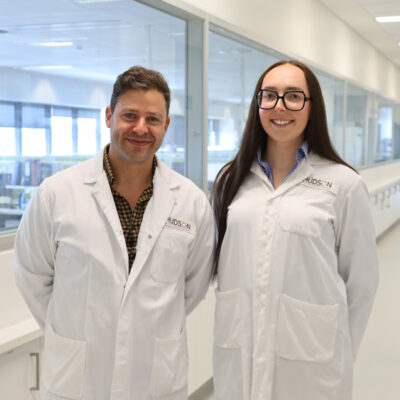Helping preterm babies avoid brain damage
By Hudson Institute communications. Reviewed by Dr Nhi Tran
High-tech images have revealed for the first time that preterm babies on ventilators could be at risk of brain injury, leading to calls for caution during treatment.

A Hudson Institute of Medical Research team worked with ANSTO Australian Synchrotron experts to scan the brains of large preterm preclinical models and investigate if the pressure exerted by ventilators could affect blood vessels and flow within the brain.
As a result, senior author Associate Professor Flora Wong, a researcher at Hudson Institute and Monash University, and consultant neonatologist at Monash Children’s Hospital, has alerted hospitals to carefully monitor their ventilation of preterm babies who now survive after as few as 23 weeks gestation.
A/Prof Wong said while ventilators were crucial in preserving life and technology was always improving, the study found it was critical to fine tune their use. “Caution should be applied when using high expiratory pressures in preterm infants,” she said.
“Over the years people have become more liberal in the use of ventilation pressure in babies. Certainly, high pressure does open up the lungs, and can help the breathing. Because this seems to have some effect that people can see immediately, they might not have thought of the effect they cannot see immediately, such as in the brain.”
More than 8000 Australian babies require mechanical ventilation each year. Until now, other scientists using more conventional methods had not been able to confirm whether the brain might be affected during those crucial early days when ventilators keep preterm babies alive.
Putting the pressure on
Published in the Journal of Applied Physiology, the study investigated the effects of high expiratory pressure of ventilators used to prevent lung collapse in extremely preterm (< 28 weeks) and very preterm babies (< 32 weeks) on the brain. The earlier a baby is born, the more likely it is to require ventilation.
ANSTO’s The Australian Synchrotron’s high intensity radiation provided high resolution images of dynamic changes to brain blood vessels, enabling scientists to measure the effect of lung pressure changes during mechanical ventilation on the brain blood flow in preterm preclinical models.
A/Prof Wong said the results should ring alarm bells and prompt change. “We have shown that a higher lung pressure causes engorgement of the brain blood vessels, which could slow down blood flow in the brain. This may play a role in preterm brain injury,” she said.
“It is a novel application of Synchrotron imaging. It’s also the first time that the preterm brain of a large preclinical model has been imaged in this way, yielding research results which could not have been obtained using conventional brain imaging methods.”
“ANSTO’s Australian Synchrotron offers unique capabilities for high speed, high resolution X-Ray movies of large preclinical specimens. This work demonstrates that such applications can be a game changer for medical research and practice,” said Dr Daniel Hausermann, Principal Scientist of ANSTO’s medical imaging facility at the Australian Synchrotron.
A team effort
Hudson Institute PhD student, Ms Nhi Tran and Postdoctoral Scientist Dr Ishmael (Mikee) Inocencio helped plan the study, perform the experiments, and interpret the data.
Dr Inocencio said the technology and expertise of those involved, including The National Cerebral and Cardiovascular Centre’s Dr James Pearson and Hudson Institute’s Group Head and Monash University Associate Professor Graeme Polglase, combined to interpret and confirm the blood vessel changes.
“It’s like an X-Ray but a high definition X-Ray,” Dr Inocencio said of Synchrotron images. “The X-Rays you get at the doctors are fuzzy. The pictures you get from this are super clear which lets us look at and study extremely small vessels in the brain.”
Ms Tran worked with Synchrotron scientists. “We had a question, and the Synchrotron scientists had the technology to help us answer it.”
“We were able to take these really clear images rapidly, about 16 images a second, and we would then piece them together to see this beautiful visualisation of the blood traversing through the brain,” she said.
“In terms of our results, we were able to see that high ventilation pressure did change these tiny vessels in the brain. And we now think, if these small vessels are stretched too much, it could lead to brain injury.”
Next steps for preterm babies research
A/Prof Wong, whose research has also identified that sleeping position can affect a preterm baby’s risk of brain damage, hopes her latest project will lead to a rethink of ventilation for preterm babies. The next steps would include verifying these results by assessing the brain in microscopic detail.
“Synchrotron imaging offers a new way to interrogate the preterm brain and investigate the brain effects of clinical conditions and treatments in preterm babies,” she said.
“Understanding what causes preterm brain injury is essential in helping us devise strategies to protect the brains of these vulnerable babies and optimise their long-term development.”
Premature birth facts
Australia
- Nine per cent of births, more than 27,000 babies, are born prematurely each year.
- Premature birth is the number one cause of newborn deaths.
- One in five preterm babies require resuscitation at birth.
- Over 48,000 babies are admitted into neonatal intensive and special care units every year in Australia.
This is over 14.5 per cent of all babies born and translates to over 115 admissions each day.
Collaborators | Monash Newborn, Monash Children’s Hospital, Department of paediatrics (Monash University), School of Health and Biomedical Sciences (RMIT University), Department of Pediatrics, Faculty of Medicine, Kagawa University, Japan, National Cerebral and Cardiovascular Centre, Osaka, Japan, Monash Biomedicine Discovery Institute and Department of Physiology, Monash University, IMBL, The Australian Synchrotron
This research was supported by | NHMRC, National Heart Foundation, MRFF
Journal | Journal of Applied Physiology
Title | Increased peak end-expiratory pressure in ventilated preterm lambs changes cerebral microvascular perfusion: direct synchrotron microangiography assessment
View publication | https://doi.org/10.1152/japplphysiol.00652.2020
In this article
About Hudson Institute
Hudson Institute’ s research programs deliver in three areas of medical need – inflammation, cancer, women’s and newborn health. More
Hudson News
Get the inside view on discoveries and patient stories
“Thank you Hudson Institute researchers. Your work brings such hope to all women with ovarian cancer knowing that potentially women in the future won't have to go through what we have!”






